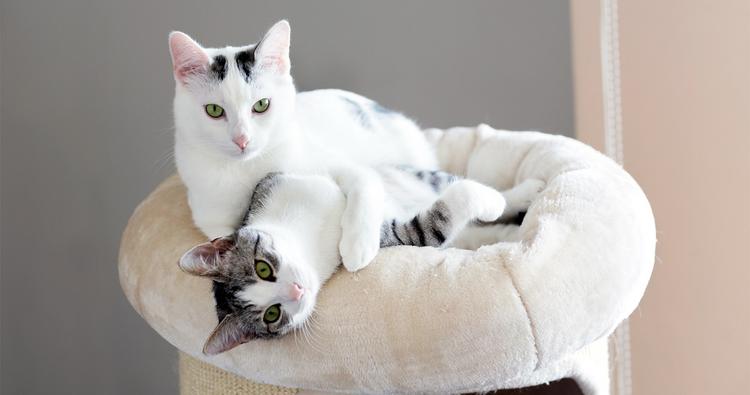Is Three Cats Too Much? Advice on Multi-Cat Households
Here are some important factors to consider when deciding how big to grow your feline family
Here are some important factors to consider when deciding how big to grow your feline family
by Katie Koschalk, | May 6, 2024

Nils Jacobi / Shutterstock
For cat lovers, the allure of adding another whiskered companion to the household can be almost irresistible. Yet, as the number of cats multiplies, so do the considerations and responsibilities. So, how do you determine the threshold of “too many”?
The truth is, there is no one-size-fits-all magic number. The appropriate number of cats in a home depends on the unique circumstances of each pet parent. With that said, let’s explore the potential advantages and drawbacks of having multiple cats.
Let’s start with some major benefits of having multiple cats.
Without sufficient stimulation, cats may become bored. “Having cats that get along and have similar play styles can prevent boredom and reduce behavior problems,” says Joey Lusvardi, a certified cat behaviorist and founder of Class Act Cats. This can help you avoid (or minimize) such issues as excessive meowing, clawing at furniture, chewing on household items, excessive grooming, or even sleeping too much.
Lusvardi also points out that multiple cats will not be solely reliant on you for their needs, reducing the likelihood of frequent interruptions. Cats who form strong bonds with each other may cuddle together, groom each other, play together, or simply provide company.
This isn’t to say that you won’t need to provide your cat with plenty of care and attention. But a multi-cat dynamic can be helpful, especially for those who have busy schedules or are away from home for extended periods each day.
Each cat brings their own personality, preferences, and quirks to the table, so you’ll be able to bond with each cat differently.
“One cat may like to snuggle up on your lap, while another cat may be really fun to play with,” Lusvardi says. “This variety will give you a range of options for spending time with cats, catering to your mood and preferences at any given moment.”
“Opening up your home to multiple cats can help keep cats out of shelters and from being euthanized due to space,” says Lusvardi. “It ultimately helps not only your cats but the whole community.”
Before you add another cat to your crew, it’s important to consider the potential challenges of having too many cats.
With each additional cat, the demand for resources such as food, scratchers, litter, and toys increases. “You can’t just get away with a single cat tower and one scratcher in one room — which isn’t a great idea for single cat homes anyway — and you’ll need multiple litter boxes,” says Lusvardi. “Many people underestimate how much stuff cats require to get along well.”
If you can’t or don’t provide enough resources, your cats may exhibit territorialism, aggression, or stress-related behaviors. This can result in fights, litter-box issues, or destructive behavior around your home.
Cats are territorial creatures, and a resident cat doesn’t always take kindly to a new cat being brought into their space. Some cats are more go-with-the-flow than others, but in general, successful cat introductions can take months and require a lot of patience, says Lusvardi. In some cases, they don’t work out, and you’ll have to rehome your new cat.
Lusvardi suggests selecting a cat similar in age, energy level, and personality to your resident cat(s) to increase the chances of success.
More cats mean more expenses. “If you have members of your household who will help with care and paying for supplies, this may be no big deal. But if it’s just you, then be prepared to budget for daily supplies and unexpected veterinary bills.”
Each cat requires individual care and attention. With too many cats, it can become challenging to devote enough time to properly tend to each one, potentially leading to behavior problems or neglect issues.
By carefully assessing your current circumstances, you can determine the most manageable number of cats for you. Here are some key factors to consider.
Generally speaking, one house cat needs at least 200 square feet of living space to be happy and healthy. Add about 100 square feet more for each additional cat. Those figures aren’t hard rules, though. The layout of your living space, the amount of vertical territory (including cat trees and shelves), and your cats’ breeds, ages, health, and personalities all come into play. Refer to our guide on how much space a cat needs to learn more.
Make sure you can accommodate the increased expenses of another cat without financial strain. The average annual cost of caring for one cat is $1,149. When adding a second cat to your household, anticipate doubling this amount. Note that this estimate doesn’t include unforeseen expenses, such as veterinary care for accidents or illnesses, which should also be factored into your budget planning.
Assess your daily schedule and commitments to determine how much time you can realistically dedicate to caring for your cats. Consider factors such as feeding, grooming, playtime, litter-box maintenance, and veterinary visits.
And don’t forget the introduction process. “If you’re expecting the cats to be integrated within a few days, you’ll be very disappointed with the results,” says Lusvardi. “It’s common for cat introductions to take weeks or months of effort before they’re fine living together.”
Reflect on how your lifestyle — including work obligations, social activities, travel plans, and any other commitments — may impact your ability to care for cats. Consider how adding more cats to your household may affect your lifestyle, and whether you have the flexibility to adapt to their needs.
As you’re reading through this information, you might still find yourself a bit unsure of how many cats you should have. Are three cats too many? Are four cats too many? What about five cats? Here are some scenarios to help you decide.
A single person in a small apartment: “If you have a tiny studio apartment, you can likely keep one cat happy, but past that, you may have difficulty,” says Lusvardi. “Cats are territorial by nature and will be very displeased if they have to share space with other cats and don’t feel there are enough resources to go around.” If you have a bigger apartment, two cats should be doable.
A couple or family living in a home: Couples or families living in houses typically have more room and helping hands to accommodate multiple cats. Generally, two to five cats can thrive in a home, but this can vary depending on the size of the space and available resources.
A busy professional in a condo or apartment: A busy professional who works long hours outside their home may have limited time to dedicate to cat care. In this scenario, two cats (who get along) may be the best choice, as they can keep each other company while their guardian is away.
Caring for multiple cats requires careful planning, organization, and commitment to ensure the well-being of each feline. Here are some tips for responsibly caring for multiple cats.
Provide adequate resources: Each cat should have easy access to essential resources like food, water, litter boxes, scratching posts, and resting areas. It’s recommended you place one litter box per cat, plus one extra, in different areas of your home (away from their food area). This prevents overcrowding and territorial issues.
Regular veterinary care: Schedule regular check-ups for each cat to maintain their health. Be vigilant for any signs of illness or discomfort, and seek veterinary attention promptly when needed.
Monitor behavior: Keep an eye on your cats’ behaviors and interactions to detect any signs of stress, aggression, or territorial issues. If your cats are being aggressive toward each other, separate them and go back a few steps in your introduction process.
Environmental safety: Create a safe, secure environment for your cats by cat-proofing your home. This includes securing windows, keeping toxic plants and substances out of reach, and putting away or disposing of small objects that could be swallowed.
Spaying/neutering: Spay or neuter all of your cats to prevent unwanted litters and reduce the risk of certain health problems and behavioral issues.
Quality time and attention: Spend quality time with each cat individually, providing affection, attention, and mental stimulation.
If you’re feeling overwhelmed by caring for multiple cats, there are resources out there that can help you better manage your feline family.
The cost of caring for multiple cats adds up. To find lower-cost vet care, visit Pet Help Finder, and click on “Veterinary Services.” Enter your city, state, or zip code – then click “Search.” This will bring up a list of lower-cost providers.
RedRover also has a comprehensive directory of national and state-specific financial aid resources.
If you’re encountering behavioral issues or conflicts among your cats, consider seeking help from a professional cat behaviorist. These experts can assess your cats’ behavior, identify underlying causes of problems, and develop personalized behavior modification plans to address them.
It’s never easy to give up a pet. But if you truly feel you have too many cats, finding one (or more) of them a new, loving home can be the most compassionate choice. Adopt a Pet’s Rehome platform can make the process as stress-free as possible. Simply create a profile for your pet, review applications, meet your top contenders, and finalize the transfer.
The ideal number of cats for you depends on your living space, resources, and ability to provide proper care and attention. Consider the needs and well-being of each cat, and make sure they have enough space, resources, and social interaction to thrive.
Legal regulations regarding the number of cats a person can have vary depending on location. However, you can usually have two to 10 cats.
Some signs you may have too many cats include overcrowding, unrelenting stress or aggression among cats, difficulty meeting the needs of each cat, financial strain due to cat-related costs, and difficulty maintaining cleanliness due to too many cats.
If you’ve determined you can comfortably accommodate another cat, explore Adopt a Pet’s customizable search tool to find your new family member.

Katie Koschalk is a freelance writer based in Northern California. Fusing her love and knowledge of animals with her journalism degree and years of professional writing, Katie is dedicated to improving the lives of pets and their caretakers by sharing helpful and accurate information. When she’s not at her desk, you can find her exploring trails with her Aussie, Hunter, cooking plant-based meals, and talking to her two cats, Jax and Sadie, in really ridiculous voices.

Breed Info

Rehome

Behavior & Training

Breed Info
Soft with stunning eyes, gray cats are almost universally gorgeous — however, their personalities can differ. Here’s a quick guide to finding the right gray cat for you.

Breed Info

Behavior & Training
Is your cat hiding? Don’t worry, it’s totally normal. Here’s how to help them adjust.

Behavior & Training

Behavior & Training

Behavior & Training

Behavior & Training

Behavior & Training

Shelters & Rescue
Not every cat will be a match for you (and vice versa). Here’s how to find “the one.”